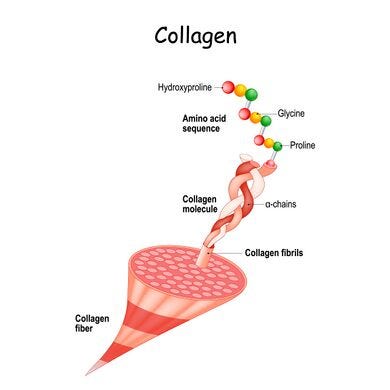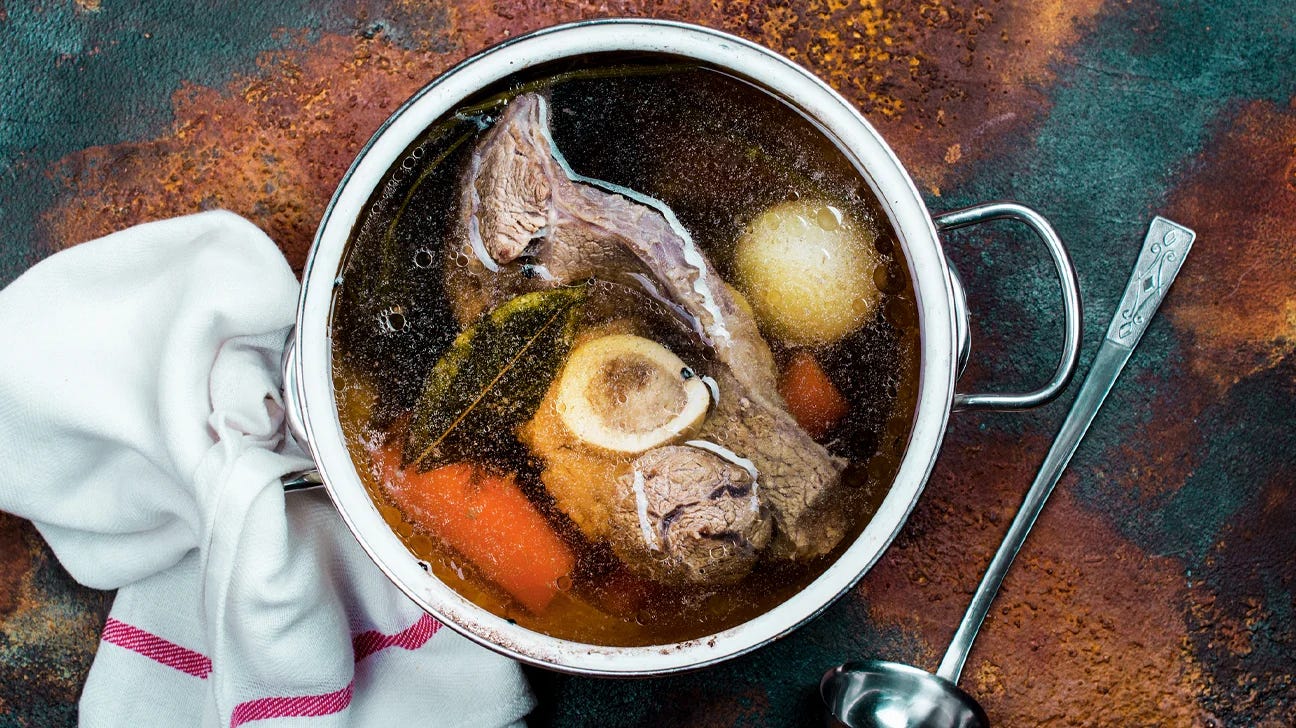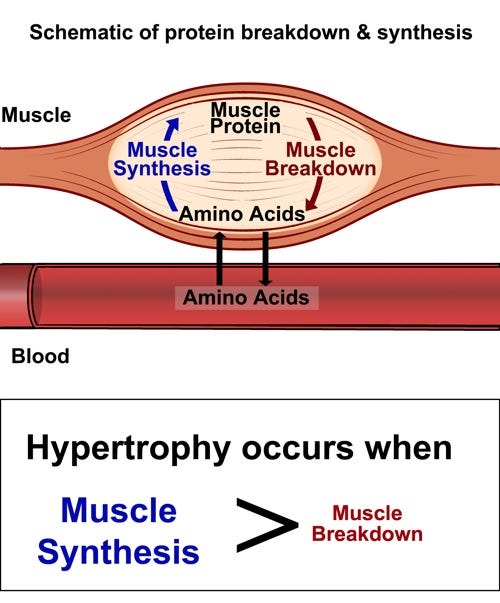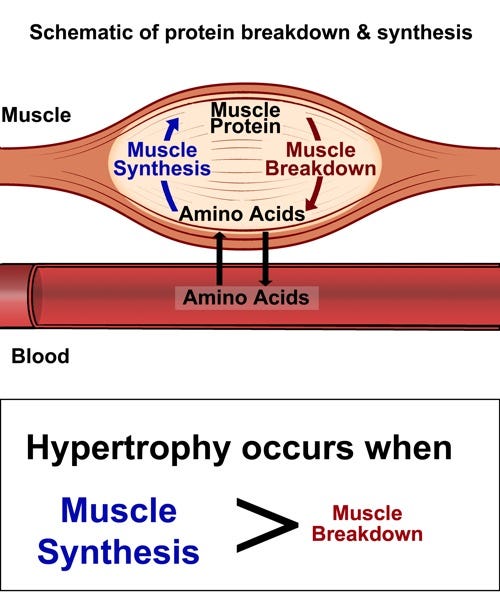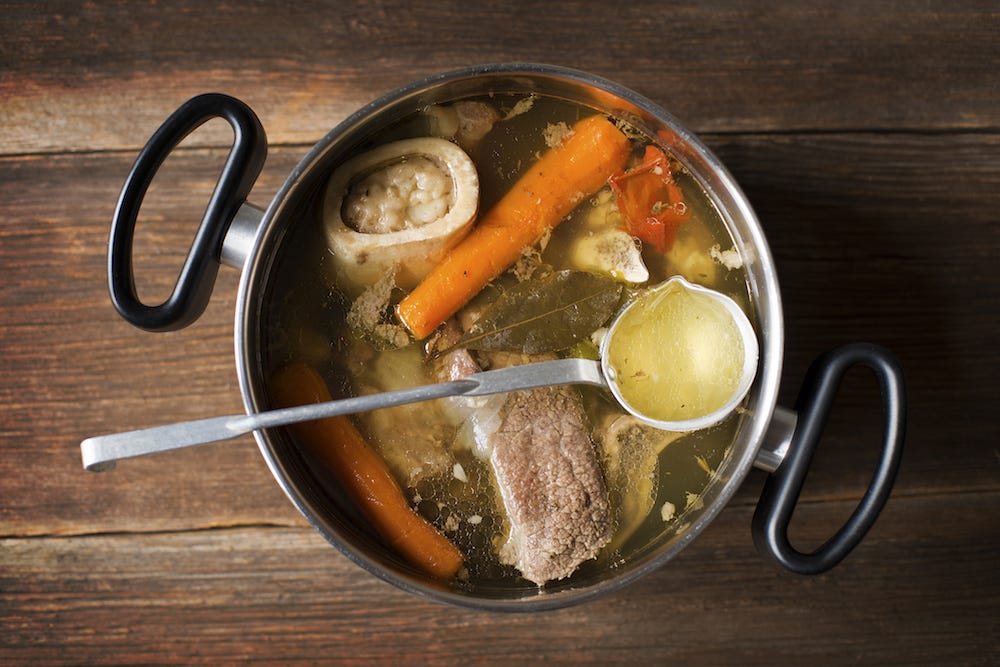Musculoskeletal Mastery: Collagen's Role in Tissue Repair and Regeneration
The Blueprint for mobility & strength
What is Collagen?
Collagen is a structural protein, it is your connective tissue, tendons, ligaments, cartilage, skin, eyes, fascia, bones, teeth, vessels, gut etc. Collagen connects everything together. A structural protein is a protein that makes up the structure of your cells and tissues. 35% of the protein in our body is collagen. 1/3 of all your collagen is made by one amino acid. This amino acid is called Glycine.
Collagen is mainly made up of glycine, proline and hydroxyproline. Collagen provides an integral support for your muscle tissues as well as your cellular processes such as; tissue repair, immune response, cellular communication & cellular migration (which is necessary for tissue maintenance). Study 1 Study 2 Study 3
Amino Acids are molecules that combine to form proteins.
The uses of Collagen
Our body naturally produces collagen, however, our body does not produce enough collagen for it to be at an optimal level. Collagen helps to treat ageing such as wrinkles, joint pain, and more.
Do we lose collagen?
We begin to lose collagen within our 20s. This leads to a reduction in bone strength Study 4. Processed foods, processed sugars & refined carbs also interfere with the ability to produce more collagen.
Skin benefits:
Multiple studies (involving women) showed that when they consumed hydrolysed collagen, it improved skin hydration, elasticity and wrinkles Study 5. Other studies showed that women who took 5grams of collagen peptides, had a significant increase in their BMD (Bone Mass Density) in their spine and femur Study 6.
Bone Mass Density is a measurement of the amount of vitamins within a bone. More minerals, the stronger the bone and the lesser the possibility that the bone will break. Our ancestors from thousands and thousands of years ago, had such great bone density, that our bones in comparison to theirs, is not really a comparison but a mockery to their BMD.
Building Better Bones: How Collagen Transforms Musculoskeletal Health
From what we know, collagen is a structural component of extracellular connective tissue. It provides elastic qualities. The extracellular tissue transmits a force to the tendons and bones which is intended for the skeletal muscles. Our connective tissue proteins are in fact in a constant sate of remodelling, which is greatly increased when performing a physical activity. To add, the consumption of dietary protein increases our muscle protein synthesis - increase in muscle mass. High quality protein sources are deemed to maximally stimulate contractile protein synthesis. However, new evidence has laid claim that protein consumption does not increase muscle connective tissue protein synthesis. But, why is this? This is due to the absence/lac of Glycine and Proline - hence a lack of increase of muscle connective tissue protein synthesis - no greater increase in muscle mass.
Dietary collagen does in fact contain large amount of glycine and proline. Glycine and proline are precursors required to facilitate connective tissue protein synthesis. So, by supplementing dietary protein that is rich in collagen, it will help to stimulate connective tissue remodelling that improves our overall health and performance.
Extracellular Connective Tissue: provides structural support for cells, tissues and organs. It is composed of water, protein, collagen and other substances.
Muscle Protein Synthesis (MPS): is a process that build muscle utilising amino acids and incorporating them into skeletal muscle proteins. Or, protein is produced to repair muscle damage due to intense exercising.
Contractile protein synthesis: is the process of creating the proteins that make up muscle fibres. Contractile proteins are essential for the contraction of muscle fibres. As old proteins are broken down, new proteins need to be formed in order to complete the contraction and to repair the muscle/s.
Glycine is a non-essential amino acid that the body uses to make protein. Our body does not produce enough glycine for it to be as affective as what it could/should be. This, therefore, in my opinion is am “essential” amino acid.
Proline is an amino acid that is a building block for proteins.
Our skeletal muscle tissue is in a constant state of remodelling. Exercise/physical activity along with the consumption of food & liquids, are the main anabolic stimuli for muscle tissue. Dietary ingestion leads to an increase in amino acids, which increases mixed muscle protein synthesis rates by at least 40-50%. During a session of physical activity, the activity (depending on intensity and effort) causes the skeletal muscle to increase the anabolic properties of the protein which was consumed. This leads to an increase of muscle mass & strength overtime (due to the anabolic properties of the consumed foods and exercise/s). Combining exercise and quality protein sources, increases muscle protein synthesis rates by 100% (Study 7, Study 8).
By completing an intense training session, albeit with heavy weights, or HIIT whilst keeping a high intensity throughout the session, whilst also consuming protein and collagen there after, it will increase your muscle protein synthesis, which will increase muscle mass, strength, tendon & ligament strength and so on. Now, if you are add some honey to your dietary consumption (if tolerable), this will also enhance the building of muscle proteins whilst increasing testosterone & DHT, strength, muscle mass, sexual drive. It is also anti-inflammatory, anti-cancer and much more (Study 9, Study 10).
Skeletal Muscle Tissue is tissue attached to our bones which allows for different varieties of movement.
Anabolic Stimuli is the build up and repairing of muscle tissues. Anabolic stimuli causes muscle hypertrophy
Muscle Protein Synthesis is a metabolic (converts food and oxygen into energy) process which turns amino acids into muscle building proteins. This builds muscle mass
Check out my posts on my newsletter regarding Raw Honey & Boost Your Testosterone with Nature’s Sweetener:Honey
Further evidence demonstrates to us that the consumption of high quality proteins that are rich in amino acids, such as dairy and other animal based proteins, are effective when it comes to stimulating mixed muscle protein synthesis. To add, These high quality proteins that are rich in amino acids, can also facilitate an increase in your muscle mass and strength, this is heightened due to your training regime. So, ensure you are training hard, lifting heavy weights, and keeping a good/high intensity throughout your training session/s (Study 11, Study 12, Study 13)
The transmission of force from muscle tissue to bone involves different factors, including the extracellular matrix (ECM). The collagenous tissue of the ECM within the skeletal muscle has an important role. What is the role? The role is to provide tissue elasticity and provide force from myofibrillar proteins in skeletal muscle fibres towards the tendons, ligaments and bones. Connective tissue function is determined by collagen and collagen fibres, connective tissue protein and collagen are constantly remodelling (further enhanced by resistance training and intense exercising (anabolic emphasis)) (Study 14 Study 15). - To add, collagen remodelling in controlled by collagen protein synthesis. Physical activity emphasises this as it increases connective tissues, which leads to a greater reconstruction & transfer of contractile force.
The extracellular matrix (ECM) is a network of proteins and molecules designed to support cells and tissues in the body.
Myofibrillar proteins are proteins that are important for muscle contraction and structure of muscle tissue.
Collagen Synthesis is when cells produce collagen to give structure & strength to tissues around the body.
Collagen protein sources such as gelatine and collagen peptides, contain great amounts of proline and glycine, especially when in comparison to whey and casein. Due to the high amounts of proline and glycine within our connective tissue, it seems sufficient that collagen protein sources (gelatine and collagen peptides) have a greater capacity to stimulate & support connective tissue protein synthesis rates & emphasise connective tissue remodelling. What is the takeaway? The conclusion is to consume collagen derived protein sources that are far richer in proline, glycine & gelatine (amino acids) such as, bone broths, chicken with the skin on, ox tail and more. Whole natural foods, in the case of animal meat/products, are most certainly, the better path to go venture down to get the benefits that collagen has on our body.
Collagen Structure & Remodelling:
Collagen is found in approximately 20-25% of all body protein. Glycine makes up about 1/3 of the make-up of collagen.
Food consumption and collagen peptides deliver anabolic stimuli and precursor amino acids to increase collagen synthesis.
The Impact of Physical Activity on Collagen Remodelling
Mechanical Loading as a Main Stimulus:
Mechanical loading is the application of a force onto a material, which influences the behaviour of said material. Mechanical loading affects different types of tissues & organs that include, bones, ligaments, tendons and skeletal muscles.
It has been suggested the mechanical loading helps to stimulate the release of growth factors such as, transforming growth factor (TGF-1), connective tissue growth factor and insulin-like growth factor (IGF-1). Some of these act directly upon fibroblasts to up-regulate collagen synthesis.
Mechanical loading was shown to up-regulate activity of lysol oxidase after resistance exercise. This suggests that prolonged methods of training could possibly lead to greater cross-linking of stiffening of connective tissue (Study 14).
Transforming Growth Factor (TGF-1) controls the activation of immune cells.
Connective Tissue Growth Factor is a protein that helps with wound healing, tissue repair and more
Insulin-Like Growth Factor (IGF-1) is a protein that stimulates the growth of different cells.
Exercise-induced adaptation in intramuscular connective tissue:
Endurance and resistance training increases muscle connective tissue protein synthesis in humans (Study 15 Study 16 Study 17).
Lengthening contraction increases post exercise intramuscular connective tissue protein synthesis rates. It reflects the potent stimulant effect of increased tension within contracting muscle tissue (Study 18 Study 19). Hence why, when i train, i try to emphasis a far greater stretch that my body is somewhat uncomfortable/in control of the stretch being performed, so that I am lengthening the targeted muscle and taking it through a much more effective range of motion. This places a greater load/tension on the targeted muscle, which will require an increase in intramuscular connective tissue protein synthesis rates, which will increase muscle mass, strength, flexibility and so on.
It is stated that the impact of prolonged exercise training training on intramuscular connective tissue protein is not “well document within humans” - but animals tests show otherwise, an increase in ICTP contents. However, in my opinion, I believe the would have the same impact on humans. In fact, I believe the impact will be far greater on man.
From what we know, exercise increases our collagen content and the level of cross-linking allows for the transmission of greater contractile forces from the muscle to the tendon, ligament and bone.
Enhanced ECM remodelling is associated with an increase in muscle mass & strength within “rodents”. Imagine the impact that this will have on you.
Intramuscular connective tissue is tissue that connects muscle fibres and fascicles.
The impact of dietary protein on collagen remodelling
Ingestion to support (muscle) tissue adaptation:
The consumption of healthy whole foods is the most important stimuli that promotes musculoskeletal tissue adaptation. The consumption of quality protein increases muscle protein synthesis rates (Study 20). An increase in essential amino acids is a key factor for up-regulating muscle protein synthesis rates (Study 21).
The anabolic response seems to be triggered by an increase in circulating leucine levels, this is supported by amino acids. Leucine consumed with protein stimulates an increase in muscle protein synthesis rates at rest and during post exercise recovery.
The consumption of dietary protein provides an anabolic signal to up-regulate muscle protein synthesis (leucine). Furthermore, it also delivers amino acids as precursors required to sustain muscle protein synthesis rates.
Leucine is an amino acid used to build proteins.
Post Exercise Connective Tissue Protein Synthesis Rates:
The combination of protein + exercise = a positive effect on muscle protein synthesis rates. A study showed that a protein feeding pattern of soy or milk protein (3g) was consumed every 30 mins. It did not increase post exercise intramuscular collagen protein synthesis rates during the early or late phase of recovery from high or low intense resistance training (Study 22).
However, my problem in the study that was carried out, is the fact that they used soy as their source of protein. Soy is terrible for you and does not have the benefits in comparison to what raw milk, for example, or non-soy milk would have. They also could have used red meat, for example, as their consumption of dietary protein.
The problem I have with the studies being carried out in regards to the consumption of said dietary protein. Is that I believe a natural whole food source of protein (eggs, red meat etc), will have produced far better results when it comes to post exercise connective tissue protein synthesis rates/recovery.
Protein that has large amounts of essential amino acids (glycine and proline) used for connective tissue protein synthesis rates, are more suitable for facilitating this.
Protein sources rich in glycine and proline, such as, beef/bone broth, ox tail, chicken skin, red meat, may be more suitable than dietary protein (whey or casein) to promote collagen synthesis. To add to the list, collagen derived protein sources such as gelatine, collagen (peptides & hydrolysate provide large amounts of proline & glycine. Therefore, collagen derived protein sources are better off when it comes to supporting your connective tissue protein remodelling (Study 23).
Digestion & Absorption of Dietary Collagen Proteins:
A study on humans showed that when the subjects consumed 5g & 15g of gelatine, it increase plasma glycine, proline, and hydroxyyproline. Gelatine does contain higher concentrations of glycine, proline and hydroxyproline. The study suggests that gelatine is digested & absorbed into circulation very effectively. Consuming 15g or gelatine in comparison to 5g, showed a greater result in peak plasma glycine, proline & hydroxyproline. The consumption of 15g of dietary collagen protein results in near-maximum rates of amino acid absorption from gelatine.
Dietary protein initiates the gains in muscle mass & strength after prolonged resistance training. Two long term studies showed that resistance training, paired with collagen peptide supplementation, further increases muscle mass & strength gains (Study 24, Study 25).
15g of collagen peptide supplementation resulted in an average increase of 4.2kg fat free mass after resistance training in men with sarcopenia (Study 26).
The anabolic impact of collagen peptide consumption, 15g worth, resulted in an average increase of 2.6kg fat free mass vs the placebo of 0.7kg after resistance training in young healthy men (Study 27Study 28).
Glycine and Proline:
Specific amino acids & peptides are essential for the up-regulation of tissue collagen synthesis and improved connective tissue function. Connective tissue proteins contain high levels of proline and glycine. Collagen protein synthesis will reamin low without the consumption of sufficient levels or glycine and proline. Hence a reduction in glycine limits the synthesis of key proteins and peptides, such as glutathione. “Regular diets” fall short of the optimal requirements of glycine and proline to be in our diets.
Conclusion:
From the evidence gathered, our musculoskeletal connective tissue networks are always in a state of remodelling. Exercising, more importantly, resistance training, increases intramuscular connective tissue protein synthesis rates - which leads to a higher level of plasticity. The consumption of collagen peptides or glycine, stimulate connective tissue protein synthesis. Furthermore, collagen protein sources contain good amounts of glycine and proline, which inevitably increase connective tissue protein synthesis rates.
I believe, and from experience, the best time to consume dietary collagen protein, bone broth for example, would be to consume it after you have had a workout (resistance training for example). Bone broth is rich in collagen and gelatine, which will mean that it is rich in glycine, and it will help with collagen protein synthesis & muscle protein synthesis after your session. This is because your muscle would have some micro-tears within the muscle fibres and protein, and your body will be repairing/remodelling the structure of the muscles targeted and the proteins. So, bone broth would be ideal when it comes to helping your muscle to rapair itself effectively. Furthermore, i also add collagen peptides to the bone broth as well as some grass fed butter, as butter is an essential saturated fat which provides you with cholesterol in order to help you with building/increasing testosterone, immune system, optimisation of the thyroid and much more. I would also look to consume dietary collagen protein like bone broth first thing in the morning/breakfast, combated with some eggs, honey, mineral/sparkling water and some meat as well.
The lack of collagen our bodies produce is a sign, in of itself, to increase the amount of collagen you consume. As our bodies lose and fail to produce an optimal amount of collagen that our body desires. With the modern food industry and processed foods we so often consume in our diets, we are completely devoid of collagen and it is a big worry.
Athletes should be consuming collagen religiously, I believe, in order to recover from their respected sports and the toll which is put onto their bodies. Especially when it comes to athletes recovering from injuries, collagen & gelatine is shown to help to increase the strength, remodelling & muscle protein synthesis rates of our tendons, ligaments, bones, fascia, skin, cartilage, connective tissue and so on.
The foods that I would consume in order to maximise collagen production would be supplementation of collagen peptides or glycine, beef/bone broth, ox tail, soups/stews with beef/ligaments & tendons etc from animals. I would add collagen peptides to my meals or add it into a warm drink, bear in mind, you would be better off staring off with smaller doses and then increasing the amount you add overtime. Chicken skin is also another good source of collagen. Collagen may also help with the overall warmth of your body, if you cook/warm up some bone/beef broth, as it has made me feel like my vril skyrocketed.
I conclude that collagen is something that must not be overlooked and I believe that it should be in our everyday diets.
Once again, this is not medical advice, do your own research into the subject matter with the materials I have provided for you here, or speak to your local doctor/health specialist for some advice.
Max out on your collagen = Collagen Maxingggg
Health is Wealth



